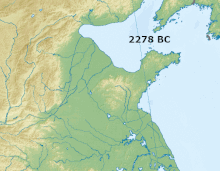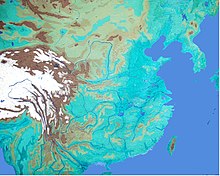Ji River
| Ji River | |||||||||
|---|---|---|---|---|---|---|---|---|---|
 The Ji River corresponding to the post-1852 lower course of the Yellow River. | |||||||||
| Traditional Chinese | TếHà | ||||||||
| Simplified Chinese | TếHà | ||||||||
| |||||||||
| Alternative Chinese name | |||||||||
| Traditional Chinese | Tế thủy | ||||||||
| Simplified Chinese | Tế thủy | ||||||||
| |||||||||
| Second alternative Chinese name | |||||||||
| Traditional Chinese | Tế thủyHà | ||||||||
| Simplified Chinese | Tế thủyHà | ||||||||
| |||||||||
| Other names | |||||||||
|---|---|---|---|---|---|---|---|---|---|
| Ji River | |||||||||
| Chinese | TểThủy | ||||||||
| |||||||||
| Yuan River | |||||||||
| Chinese | OanThủy | ||||||||
| Literal meaning | Bendy River | ||||||||
| |||||||||
TheJi Riverwas a formerriverin north-eastern China which gave its name to the towns ofJiyuanandJinan.It disappeared during one of the massive Yellow River floods of 1852, as theYellow Rivershifted its course from below theShandong Peninsulato north of it. In the process, it overtook the Ji and assumed its bed.
Name
[edit]Jǐis thepinyinromanizationof the present-dayMandarinpronunciation of theChinesenamewrittenTếintraditional charactersandTếin thesimplified formused inmainland China.The river'sOld Chinesepronunciation has beenreconstructedas /*[ts]ˤəjʔ/[1]or /*ʔsliːlʔ/.[2]Ancient Chinese accounts also wrote the name with the characterTể,[3][4]andLin Chuanjiaconsidered this to be identical with theYuan Riverthat gaveYuanqu Countyits name.[5][6]
Geography
[edit]
The Ji River changed its precise course several times over the historical period before its disappearance.[3]Generally, it traced its course from an origin nearJiyuan[7]in what is nowHenan ProvincethroughShandongto theBohai Sea.[8]
During theNeolithic,the Ji was probably a tributary of theYellow River,merging with its lower course in theNorth China Plain.[9]
At some point, its flooding shifted the lower course of the Yellow River into a separate channel, while the Ji continued to occupy its earlier path. The two rivers ran parallel to one another under theZhou,[10]Qin,andHan.[11]
Under the Han, the Ji River's central course passed through theGreat Wild Marsh(tĐại dã trạch,sĐại dã trạch,Dàyězé) and itsmouthwas inQiansheng Commandery(Thiên thừaQuận,Qiānchéng Jùn).[3]
History
[edit]The area around the Ji River was among the most densely populated in China during theNeolithic Age,[12]when its plains were a center for theLongshan[13]andYueshi cultures.[14]It was honored as a god inancient Chinese religion.[15]
Sima Qianlists the Ji among the rivers connected by theHonggou Canal(tHồng câu,sHồng câu,Hónggōu,"Canal of the Wild Geese" ),[16]whose remote antiquity caused him to place it next after the works of the legendary figureYu the Great.[17]In fact, theHeshui Canal(tHà thủyVận hà,sHà thủyVận hà,Héshuǐ Yùnhé) connecting the Ji to theSiwas completed by soldiers under the command ofKing FuchaiofWuin 483 and 482BC in order to improve their supply lines while at war with the northernstatesofQiandJin.[10]From the Si, the Ji River then had access to theHuai River,which connected to the new course of theYellow Riverthrough the Hongguo Canal and with theYangtze Riverthrough theHangou Canaljust completed by Fuchai's men in 486BC.[10]
Under theZhou,thestateofQiwas centered on the broadfloodplainof the Ji.[8]It also used the "clear Ji" along with the "muddyYellow River"as part of its borders with and defenses against the states ofYanandZhao.[18]During antiquity, the river was a center ofsalt production.[3]
The river went dry during theWeiandJinperiod (3rd–4th centuryAD).[7]
The Ji finally disappeared during one of the massive Yellow River floods of 1852,[19]as theYellow Rivershifted its course from below theShandong Peninsulato north of it. In the process, it overtook the Ji and assumed its bed. Other parts of the former course of the Ji form the presentXiaoqing River.[7]
Legacy
[edit]The Ji River was the namesake ofJiyuan( "Source of the Ji" ) andJinan( "Lands South of the Ji" ).[7]
References
[edit]Citations
[edit]- ^Baxter & al. (2014).
- ^Zhengzhang (2003).
- ^abcdBarbieri-Low & al. (2015),p.943.
- ^《 hán điển 》,2015, s.v."Tể".(in Chinese)
- ^Lin (1920).
- ^Ding (2014).
- ^abcdLiu (2004),p.254.
- ^abJun (2013),p.145.
- ^Liu (2004),p.205.
- ^abcZhao (2015),p.206.
- ^Barbieri-Low & al. (2015),p.lxvi.
- ^Chen (2015),p.82.
- ^Liu (2004),pp.27&205.
- ^Liu (2004),p.207.
- ^Chen (2015),p.132.
- ^Needham & al. (1971),p.269.
- ^Needham & al. (1971),p.270.
- ^Jing (2015),p.22.
- ^Pletcher & al. (2011),p.171.
Bibliography
[edit]- Barbieri-Low, Anthony J.; et al. (2015),Law, State, and Society in Early Imperial China,Sinica Leidensia,No. 247, Leiden: Brill,ISBN9789004300538.
- Baxter, William Hubbard III;et al. (2014),Baxter–Sagart Old Chinese Reconstruction,Ver. 1.1(PDF),Ann Arbor: University of Michigan.
- Chen Anze; et al. (2015),The Principles of Geotourism,Heidelberg: Springer Geography,ISBN9783662466971.
- Ding Huiying (30 Dec 2014),"Quan vu oan cú cố thành tại sơn đông tỉnh hà trạch thị mẫu đan khu cảnh nội đích khảo chứng [Guānyú Yuānqú Gùchéng zài Shāndōng Shěng Hézé Shì Mǔdan Qū Jìngnèi de Kǎozhèng, About the Research on the Ancient City of Yuanqu in Mudan District, Heze, Shandong Province]",Official site,Heze: Heze Municipal People's Government.(in Chinese)
- Jing Ai (2015), Wang Gangliu; et al. (eds.),A History of the Great Wall of China,New York: SCPG Publishing,ISBN9781938368325.
- Jun Wenren (2013),Ancient Chinese Encyclopedia of Technology: Translation and Annotation of theKaogong Ji(The Artificers' Record),Routledge Studies in the Early History of Asia,No. 7, Abingdon: Routledge,ISBN9781136267888.
- Lin Chuanjia (1920),《 đại trung hoa sơn đông địa lý chí 》 [Dà Zhōnghuà Shāndōng Dìlǐ Zhì,Great Record of the Geography of Shandong, China],Beijing: Wuxue Shuguan.(in Chinese)
- Liu Li (2004),The Chinese Neolithic: Trajectories to Early States,New Studies in Archaeology,Cambridge:Cambridge University Press,ISBN9781139441704.
- Needham, Joseph;et al. (1971),Science & Civilization in China,Vol. IV:Physics and Physical Technology,Pt. III:Civil Engineering and Nautics,Cambridge:Cambridge University Press,ISBN9780521070607.
- Pletcher, Kenneth; et al., eds. (2011), "The Major Cities of Northern China",The Geography of China: Sacred and Historic Places,Understanding China, New York: Britannica Educational Publishing, pp. 151–182,ISBN9781615301348.
- Zhao Dingxin (2015),The Confucian-Legalist State: A New Theory of Chinese History,Oxford: Oxford University Press,ISBN9780199351732.
- Zhengzhang Shangfang(2003),《 thượng cổ âm hệ 》 [Shànggǔ Yīnxì,Old Chinese Phonology],Shanghai: Shanghai Educational Publishing.(in Chinese)
